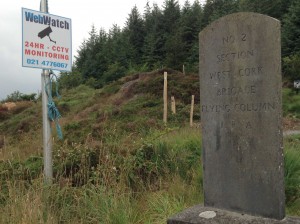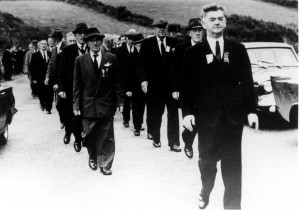Another controversy at Kilmichael
Published in Issue 6 (November/December 2014), Platform, Volume 22
Several unsightly large signs were also erected in the middle of the ambush site, warning visitors of ‘24-hour CCTV monitoring’.
The destruction of a convoy of RIC Auxiliaries by an IRA flying column at Kilmichael, West Cork, in November 1920 was one of the most notable events in the War of Independence. In recent years claim and counter-claim about the Kilmichael ambush have generated a very heated debate among scholars, and inspired a large number of letters to the editor of this magazine and the national press. Now a fresh controversy has erupted, focusing not on the event itself but on how the site of the ambush should be preserved and whether recent development work has destroyed the integrity of this important historical site.
Until the 1960s the ambush site was marked by a simple iron cross. This was replaced by a large monument erected on the roadside to commemorate the republicans killed in the attack, and several smaller stones were erected to mark the ambush positions held by the IRA. In 2013 the Kilmichael History Society and the Kilmichael– Crossbarry Commemoration Committee made a successful application for planning permission to ‘preserve and enhance’ the ambush site. The finished works have divided opinion between those who argue that the site has been improved and those who claim that irreparable damage has been done.
There’s no denying that the site was neglected in recent years. The monument was in a state of dis-repair and badly needed cleaning. Access was difficult, ‘fly-tipping’ was commonplace and lack of signage meant that passers-by frequently confused Kilmichael with Bealnablath. Proposals to develop the site first caused controversy when it was noted that they included the erection of a full-size replica of a British Crossley Tender and spoke of ‘suitable commemoration for both IRA Volunteers and [RIC] Auxiliaries’. This raised protests that commemoration of the Auxiliaries would be highly inappropriate, given their record in the locality. Those behind the project strongly deny that it was ever their intention to commemorate the Auxiliaries, and the Crossley Tender element was dropped.
My concern here is not to rehash that rather heated debate but to examine the impact of the actual work carried out at Kilmichael. As well as the erection of new signage, the development includes extensive changes to the battlefield, with the addition of concrete paving, park benches, gravel paths, a very large concrete wheelchair ramp and several picnic tables. Dozens of 7ft-tall ash poles, each fitted with stainless steel banding, were erected to illustrate the distribution of the IRA ambushers. Several large, unsightly signs were also erected in the middle of the ambush site, warning visitors of ’24-hour CCTV monitoring’.
Heavy machinery was used during these works and a section of the ambush site where two of the Auxiliaries (Cadets Taylor and Pallister) were killed was ‘re-sculpted’ (bulldozed?) in the process. This work was carried out without any detailed archaeological survey or excavation. The planning application submitted by the group recognised the importance of archaeology and gave an undertaking to ‘ensure the presence of an archaeologist on site during any excavations’, but they failed to adhere to this commitment. Cork County Council’s archaeologist viewed the site before works began, but the developers did not hire an archaeology firm to monitor work at the site thereafter.
Both the County Council archaeologist and an official from the Heritage Council advised the local groups that they should consult an archaeologist with specific expertise in battlefield archaeology regarding their plans. Members of the local groups involved admit that they did not follow this advice. They also admit that they did not research the preservation of foreign battlefields when formulating their plans or study international guidelines regarding the preservation of modern battlefields.
Had they studied these guidelines or sought the expertise of a battlefield archaeologist, they would probably have been advised to radically alter their plans. The alteration of existing features and damage through over-development are considered the biggest threats to the preservation of battlefields. I visited Kilmichael with Damian Shiels, a qualified archaeologist specialising in battlefield archaeology, who told me:
‘The archaeological integrity of the Kilmichael ambush site has been effectively destroyed by the recent landscaping works. In parts of the battlefield it will no longer be possible to accurately assess the 1920 terrain, or retrieve artefacts from original locations. This is not how you preserve a battlefield.’
I also met Commandant (rtd) Seán A. Murphy, who has 23 years’ service in the Irish Defence Forces, mostly as an ordnance mechanical engineer, and an extensive knowledge of weapons and ammunition effects. He has just published a book, Kilmichael: a battlefield study (self-published, available on-line). Like Shiels, he is also critical of the recent work and argues that the integrity of the site has been compromised:
‘Kilmichael is arguably “the” military action of the War of Independence. Due to the paucity of what can be considered “true battle sites” in Ireland, we have given little consideration as to how they should be preserved, the current development of the Kilmichael site being a case in point. Military purists would argue for its complete preservation, keeping only the vegetation in check to allow an appreciation of the terrain features which are crucial in assessing the conduct of the operation.’
Murphy argues that an excavation of the site could have yielded very significant new information about the engagement. Immediately after the ambush a British officer drew a detailed map, marking the exact location of the bodies of the dead Auxiliaries. Murphy contends that if these areas had been excavated the bullet fragments recovered could have indicated whether these men were killed from a distance in battle or summarily executed at ‘point-blank range’.

Tom Barry heads IRA survivors of the Kilmichael ambush at the site in 1966. Would they recognise it today? (Meda Ryan)
Such information could have been invaluable in helping to settle the dispute between traditional accounts of the ambush, which maintain that the Auxiliaries died in battle, and the controversy sparked by Canadian historian Peter Hart, who claimed that several of the Auxiliaries were killed after being taken prisoner. Unfortunately the failure to carry out a full excavation of the ambush site before the recent works began means that valuable historical data may have been irretrievably lost.
Those who planned the ‘enhancement’ of the ambush site were probably well intentioned, but the opinion of those with expertise that significant harm was done in the process cannot be ignored. The recent works at the Kilmichael ambush site received ?77,750 in funds from the West Cork Development Partnership. Questions arise as to how such a large sum of public money was spent on the ‘preservation’ of such an important historical site by a group who repeatedly ignored advice from professionals to employ the expertise of a battlefield archaeologist. Questions also need to be asked about the value of the project, given that it was apparently planned without first conducting a study of inter-national best practice in Britain, America and Europe regarding the preservation of historical sites and battlefields.
The most serious issue that arises from this most recent Kilmichael controversy is the complete lack of legislation in Ireland protecting historical sites associated with the 1916 Rising, War of Independence and Civil War. This is not so much a legal ‘grey area’ as a ‘black hole’. Although these sites are of great historical significance, they are apparently too recent in age to be afforded protection as ‘battlefields’ and, because they rarely contain built structures, they cannot be classed as ‘monuments’.
This is likely to lead to further problems during the ‘Decade of Centenaries’. The debate about the preservation of buildings in Moore Street occupied during the 1916 Rising has already raged for over a decade without a definite conclusion. The site of another War of Independence ambush at Cúil na Cathrach, near Macroom, was recently threatened with obliteration by the construction of a proposed bypass. At present, once planning is approved, it appears that there are no heritage laws to stop developers heading for Soloheadbeg, Bealnablath or any other ambush site with cement-mixers and bulldozers!
Pádraig Óg Ó Ruairc has recently submitted a Ph.D thesis on the War of Independence at the University of Limerick and is the author of Revolution: a photographic history of revolutionary Ireland 1913–1923 (Mercier Press, 2011).
















